Adonis
Adonis[lower-alpha 1] was the mortal lover of the goddess Aphrodite in Greek mythology. In Ovid's first-century AD telling of the myth, he was conceived after Aphrodite cursed his mother Myrrha to lust after her own father, King Cinyras of Cyprus. Myrrha had sex with her father in complete darkness for nine nights, but he discovered her identity and chased her with a sword. The gods transformed her into a myrrh tree and, in the form of a tree, she gave birth to Adonis. Aphrodite found the infant and gave him to be raised by Persephone, the queen of the Underworld. Adonis grew into an astonishingly handsome young man, causing Aphrodite and Persephone to feud over him, with Zeus eventually decreeing that Adonis would spend one third of the year in the Underworld with Persephone, one third of the year with Aphrodite, and the final third of the year with whomever he chose. Adonis chose to spend his final third of the year with Aphrodite.
| Adonis | |
|---|---|
God of beauty, desire and vegetation | |
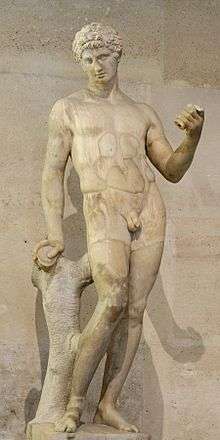 Nude Roman torso of Adonis, restored and completed by François Duquesnoy, formerly in the collection of Cardinal Mazarin, currently held in the Louvre Museum | |
| Abode | Lebanon |
| Symbol | anemones, as well as lettuce, fennel, and other fast-growing plants |
| Personal information | |
| Parents | Cinyras and Myrrha (by Ovid), Phoenix and Alphesiboea (by Hesiod) |
| Spouse | Aphrodite |
| Children | Golgos, Beroe |
| Equivalents | |
| Mesopotamian equivalent | Dumuzid, Tammuz |
| Levantine/Canaanite equivalent | Tammuz, Adonis |
One day, Adonis was gored by a wild boar during a hunting trip and died in Aphrodite's arms as she wept. His blood mingled with her tears and became the anemone flower. Aphrodite declared the Adonia festival commemorating his tragic death, which was celebrated by women every year in midsummer. During this festival, Greek women would plant "gardens of Adonis", small pots containing fast-growing plants, which they would set on top of their houses in the hot sun. The plants would sprout, but soon wither and die. Then the women would mourn the death of Adonis, tearing their clothes and beating their breasts in a public display of grief.
The Greeks considered Adonis's cult to be of Oriental origin. Adonis's name comes from a Canaanite word meaning "lord" and most modern scholars consider the story of Aphrodite and Adonis to be derived from the earlier Mesopotamian myth of Inanna (Ishtar) and Dumuzid (Tammuz).
In late nineteenth and early twentieth century scholarship of religion, Adonis was widely seen as a prime example of the archetypal dying-and-rising god, but the existence of the "dying-and-rising god" archetype has been largely rejected by modern scholars. His name is often applied in modern times to handsome youths, of whom he is the archetype.
Cult
Origin
The worship of Aphrodite and Adonis is probably a Greek continuation of the ancient Sumerian worship of Inanna and Dumuzid.[5][7][2] The Greek name Ἄδωνις (Ádōnis), Greek pronunciation: [ádɔːnis]) is derived from the Canaanite word ʼadōn, meaning "lord".[1][2][3][4][5] This word is related to Adonai (Hebrew: אֲדֹנָי), one of the titles used to refer to the God of the Hebrew Bible and still used in Judaism to the present day.[4] The Syrian name for Adonis is Gaus.[8]
The cult of Inanna and Dumuzid may have been introduced to the Kingdom of Judah during the reign of King Manasseh.[9] Ezekiel 8:14 mentions Adonis under his earlier East Semitic name Tammuz[10][11] and describes a group of women mourning Tammuz's death while sitting near the north gate of the Temple in Jerusalem.[10][11]
The earliest known Greek reference to Adonis comes from a fragment of a poem by the Lesbian poet Sappho (c. 630 – c. 570 BC),[12] in which a chorus of young girls asks Aphrodite what they can do to mourn Adonis' death.[12] Aphrodite replies that they must beat their breasts and tear their tunics.[12] The cult of Adonis has also been described as corresponding to the cult of the Phoenician god Baal.[5] As Walter Burkert explains:
Women sit by the gate weeping for Tammuz, or they offer incense to Baal on roof-tops and plant pleasant plants. These are the very features of the Adonis legend: which is celebrated on flat roof-tops on which sherds sown with quickly germinating green salading are placed, Adonis gardens... the climax is loud lamentation for the dead god.[13]
The exact date when the worship of Adonis became integrated into Greek culture is still disputed. Walter Burkert questions whether Adonis had not from the very beginning come to Greece along with Aphrodite.[13] "In Greece," Burkert concludes, "the special function of the Adonis legend is as an opportunity for the unbridled expression of emotion in the strictly circumscribed life of women, in contrast to the rigid order of polis and family with the official women's festivals in honour of Demeter."[13] The significant influence of Near Eastern culture on early Greek religion in general, and on the cult of Aphrodite in particular,[14] is now widely recognized as dating to a period of orientalization during the eighth century BC,[14] when archaic Greece was on the fringes of the Neo-Assyrian Empire.[15]
In Cyprus, the cult of Adonis gradually superseded that of Cinyras. W. Atallah suggests that the later Hellenistic myth of Adonis represents the conflation of two independent traditions.[16]
Festival of Adonia

The worship of Adonis is associated with the festival of the Adonia, which was celebrated by Greek women every year in midsummer.[2][17] The festival, which was evidently already celebrated in Lesbos by Sappho's time in the seventh century BC, seems to have first become popular in Athens in the mid-fifth century BC.[2][1] At the start of the festival, the women would plant a "garden of Adonis", a small garden planted inside a small basket or a shallow piece of broken pottery containing a variety of quick-growing plants, such as lettuce and fennel, or even quick-sprouting grains such as wheat and barley.[2][18][13] The women would then climb ladders to the roofs of their houses, where they would place the gardens out under the heat of the summer sun.[2][13] The plants would sprout in the sunlight, but wither quickly in the heat.[19] While they waited for the plants to first sprout and then wither, the women would burn incense to Adonis.[13] Once the plants had withered, the women would mourn and lament loudly over the death of Adonis, tearing their clothes and beating their breasts in a public display of grief.[20][13] The women would lay a statuette of Adonis out on a bier and then carry it to the sea along with all the withered plants as a funeral procession.[13][21] The festival concluded with the women throwing the effigy of Adonis and the withered plants out to sea.[13]
In classical literature
Ovid's Metamorphoses
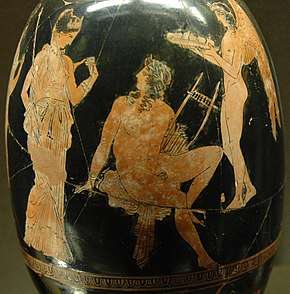
While Sappho does not describe the myth of Adonis, later sources flesh out the details.[22] According to the retelling of the story found in the poem Metamorphoses by the Roman poet Ovid (43 BC – 17/18 AD), Adonis was the son of Myrrha, who was cursed by Aphrodite with insatiable lust for her own father, King Cinyras of Cyprus,[23] [24][25] after Myrrha's mother bragged that her daughter was more beautiful than the goddess.[23][24] Driven out after becoming pregnant, Myrrha was changed into a myrrh tree, but still gave birth to Adonis.[23][26][27] According to classicist William F. Hansen, the story of how Adonis was conceived falls in line with the conventional ideas about sex and gender that were prevalent in the classical world, since the Greeks and Romans believed that women, such as Adonis's mother Myrrha, were less capable of controlling their primal wants and passions than men.[28]
Aphrodite found the baby,[29] and took him to the underworld to be fostered by Persephone.[29] She returned for him once he was grown[29] and discovered him to be strikingly handsome.[29] Persephone wanted to keep Adonis;[29] Zeus settled the dispute by decreeing that Adonis would spend one third of the year with Aphrodite, one third with Persephone, and one third with whomever he chose.[29] Adonis chose Aphrodite, and they remained constantly together.[29]
Then, one day while Adonis was out hunting, he was wounded by a wild boar, and bled to death in Aphrodite's arms.[29] In different versions of the story, the boar was either sent by Ares, who was jealous that Aphrodite was spending so much time with Adonis,[30] by Artemis, who wanted revenge against Aphrodite for having killed her devoted follower Hippolytus,[30] or by Apollo, to punish Aphrodite for blinding his son Erymanthus.[31] The story also provides an etiology for Aphrodite's associations with certain flowers.[30] Reportedly, as she mourned Adonis's death, she caused anemones to grow wherever his blood fell,[29][30] and declared a festival on the anniversary of his death.[29]
Other versions
In Idyll 15 by the early third-century BC Greek bucolic poet Theocritus, Adonis is described as a still an adolescent with down on his cheeks at the time of his love affair with Aphrodite, in contrast to Ovid's Metamorphoses in which he is portrayed as a fully mature man.[32] Pseudo-Apollodorus (Bibliotheke, 3.182) describes Adonis as the son of Cinyras, of Paphos on Cyprus, and Metharme. According to Pseudo-Apollodorus's Bibliotheke, Hesiod, in an unknown work that does not survive, made of him the son of Phoenix and the otherwise unidentified Alphesiboea.[33]
In one version of the story, Aphrodite injured herself on a thorn from a rose bush[30] and the rose, which had previously been white, was stained red by her blood.[30] In other version an anemone flower grew on the spot where Adonis died, and a red rose where Aphrodite's tears fell.[34] The third century BC poet Euphorion of Chalcis remarked in his Hyacinth that "Only Cocytus washed the wounds of Adonis".[35] According to Lucian's De Dea Syria,[36] each year during the festival of Adonis, the Adonis River in Lebanon (now known as the Abraham River) ran red with blood.[29]
In post-classical literature culture
The medieval French poet Jean de Meun retells the story of Adonis in his additions to the Roman de la Rose, written in around 1275.[32] De Muen moralizes the story, using it as an example of how men should heed the warnings of the women they love.[32] In Pierre de Ronsard's poem "Adonis" (1563), Venus laments that Adonis did not heed her warning, but ultimately blames herself for his death, declaring, "In need my counsel failed you."[32] In the same poem, however, Venus quickly finds another shepherd as her lover, representing the widespread medieval belief in the fickleness and mutability of women.[32]
The story of Venus and Adonis from Ovid's Metamorphoses was tremendously influential during the Elizabethan era.[37] In Edmund Spenser's epic poem The Faerie Queene (1590), tapestries depicting the story of Adonis decorate the walls of Castle Joyous.[32] Later in the poem, Venus takes the character Amoretta to raise her in the "Garden of Adonis".[32] Ovid's portrayal of Venus's desperate love for Adonis became the inspiration for many literary portrayals in Elizabethan literature of both male and female courtship.[37]
William Shakespeare's erotic narrative poem Venus and Adonis (1593), a retelling of the courtship of Aphrodite and Adonis from Ovid's Metamorphoses,[38][39] was the most popular of all his works published within his own lifetime.[40][41] Six editions of it were published before Shakespeare's death (more than any of his other works)[41] and it enjoyed particularly strong popularity among young adults.[40] In 1605, Richard Barnfield lauded it, declaring that the poem had placed Shakespeare's name "in fames immortall Booke".[41] Despite this, the poem has received mixed reception from modern critics.[40] Samuel Taylor Coleridge defended it, but Samuel Butler complained that it bored him and C. S. Lewis described an attempted reading of it as "suffocating".[40]
The story of Adonis was the inspiration for the Italian poet Giambattista Marino to write his mythological epic L'Adone (1623), which outsold Shakespeare's First Folio.[32] Marino's poem focuses on the pleasures of love, which it describes explicitly.[32] It describes Adonis as shooting the boar with Cupid's arrow and proclaims the tusk that crushes his hip a "loving" one.[32] Shakespeare's homoerotic descriptions of Adonis's beauty and Venus's masculine pursuit of him inspired the French novelist and playwright Rachilde (Marguerite Vallette-Eymery) to write her erotic novel Monsieur Vénus (1884), about a noblewoman named Raoule de Vénérande who sexually pursues a young, effeminate man named Jacques who works in a flower shop.[42] Jacques is ultimately shot and killed in a duel, thus following the model of Adonis's tragic death.[42]
As a dying and rising god
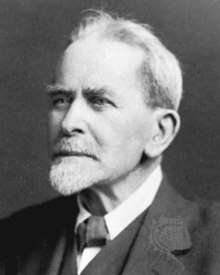
The late nineteenth-century Scottish anthropologist Sir James George Frazer wrote extensively about Adonis in his monumental study of comparative religion The Golden Bough (the first edition of which was published in 1890)[43][46] as well as in later works.[47] Frazer claimed that Adonis was just one example of the archetype of a "dying-and-rising god" found throughout all cultures.[44][43][48] In the mid-twentieth century, some scholars began to criticize the designation of "dying-and-rising god", in some cases arguing that deities like Adonis, previously referred to as "dying and rising", would be better termed separately as "dying gods" and "disappearing gods",[49][50] asserting that gods who "died" did not return, and those who returned never "really" died.[49][50] Biblical scholars Eddy and Boyd (2007) applied this rationale to Adonis based on the fact that his portion of the year spent in the Underworld with Persephone is not really a death and resurrection, but merely an instance of a living person staying in the Underworld.[51] They further argued that Adonis is not explicitly described as rising from the dead in any extant Classical Greek writings,[51][13] though the fact that such a belief existed is attested by authors in Late Antiquity.[51] For example, Origen discusses Adonis, whom he associates with Tammuz, in his Selecta in Ezechielem ( “Comments on Ezekiel”), noting that "they say that for a long time certain rites of initiation are conducted: first, that they weep for him, since he has died; second, that they rejoice for him because he has risen from the dead (apo nekrôn anastanti)" (cf. J.-P. Migne, Patrologiae Cursus Completus: Series Graeca, 13:800). Some other scholars have continued to cite Adonis/Tammuz as an example of a dying and rising god, suggesting that the descent into and return from the underworld is a functional analogue for death even if no physical cause of death is depicted.[52][53][54]
See also
- Adonia, feasts celebrating Adonis
- Adonism
- Apheca
- Myrrha, mother of Adonis per Greek mythology
- Adonis belt
Psychology:
- Muscle dysmorphia, as part of Adonis Complex
- Theorizing about Myth, a Jungian interpretation of the Adonis myth by R. Segal
Notes
References
- Burkert 1985, pp. 176–177.
- Cyrino 2010, p. 97.
- R. S. P. Beekes, Etymological Dictionary of Greek, Brill, 2009, p. 23.
- Botterweck & Ringgren 1990, pp. 59–74.
- West 1997, p. 57.
- Lung 2014.
- Kerényi 1951, p. 67.
- Detienne 1994, p. 137.
- Pryke 2017, p. 193.
- Pryke 2017, p. 195.
- Warner 2016, p. 211.
- West 1997, pp. 530–531.
- Burkert 1985, p. 177.
- Burkert 1998, pp. 1–6.
- Burkert 1998, pp. 1–41.
- Atallah 1966
- W. Atallah, Adonis dans la littérature et l'art grecs, Paris, 1966.
- Detienne 1972.
- Cyrino 2010, pp. 97–98.
- Cyrino 2010, p. 98.
- Detienne, Marcel (1977). "Introduction by J.-P. Vernant". The Gardens of Adonis: Spices in Greek Mythology. Translated by Lloyd, Janet. New Jersey: The Humanities Press. pp. xii.
- Cyrino 2010, p. 95.
- Ovid, Metamorphoses X, 298–518
- Kerényi 1951, p. 75.
- Hansen 2004, p. 289.
- Kerényi 1951, pp. 75–76.
- Hansen 2004, pp. 289–290.
- Hansen 2004, p. 290.
- Kerényi 1951, p. 76.
- Cyrino 2010, p. 96.
- According to Nonnus, Dionysiaca 42.1f. Servius on Virgil's Eclogues x.18; Orphic Hymn lv.10; Ptolemy Hephaestionos, i.306u, all noted by Graves. Atallah (1966) fails to find any cultic or cultural connection with the boar, which he sees simply as a heroic myth-element.
- Hull 2010, p. 7.
- Ps.-Apollodorus, iii.14.4.1.
- Roman, L., & Roman, M. (2010). Encyclopedia of Greek and Roman mythology., p. 11, at Google Books
- Remarked upon in passing by Photius, Biblioteca 190 (on-line translation).
- Kerényi 1951, p. 279.
- Hull 2010, pp. 7–8.
- Lákta 2017, pp. 56–58.
- Cyrino 2010, p. 131.
- Lákta 2017, p. 58.
- Hiscock 2017, p. unpaginated.
- Hull 2010, p. 8.
- Ehrman 2012, pp. 222–223.
- Barstad 1984, p. 149.
- Eddy & Boyd 2007, pp. 142–143.
- Mettinger 2004, p. 375.
- Barstad 1984, pp. 149–150.
- Eddy & Boyd 2007, pp. 140–142.
- Smith 1987, pp. 521–527.
- Mettinger 2004, p. 374.
- Eddy & Boyd 2007, p. 143.
- Dalley 1998.
- Corrente 2012.
- Corrente 2019.
Bibliography
- Barstad, Hans M. (1984), The Religious Polemics of Amos: Studies in the Preaching of Am 2, 7B-8; 4,1-13; 5,1-27; 6,4-7; 8,14, Leiden, The Netherlands: Brill, ISBN 9789004070172CS1 maint: ref=harv (link)
- Botterweck, G. Johannes; Ringgren, Helmer (1990), Theological Dictionary of the Old Testament, VI, Grand Rapids, Michigan: Wm. B. Eerdmans Publishing Co., ISBN 978-0-8028-2330-4CS1 maint: ref=harv (link)
- Burkert, Walter (1985), Greek Religion, Cambridge, Massachusetts: Harvard University Press, ISBN 0-674-36281-0CS1 maint: ref=harv (link)
- Burkert, Walter (1998) [1992], The Orientalizing Revolution: Near Eastern Influence on Greek Culture in the Early Archaic Age, Harvard University Press, ISBN 978-0674643642
- Corrente, Paola (2012), Dioniso y los Dying gods: paralelos metodológicos, Universidad Complutense de MadridCS1 maint: ref=harv (link)
- Corrente, Paola (2019), Philology and the Comparative Study of Myths, The Religious Studies Project
- Cyrino, Monica S. (2010), Aphrodite, Gods and Heroes of the Ancient World, New York City, New York and London, England: Routledge, ISBN 978-0-415-77523-6CS1 maint: ref=harv (link)
- Detienne, Marcel, 1972. Les jardins d'Adonis, translated by Janet Lloyd, 1977. The Gardens of Adonis, Harvester Press.
- Dalley, Stephanie (1989), Myths from Mesopotamia: Creation, the Flood, Gilgamesh, and Others, Oxford, England: Oxford University Press, ISBN 978-0-19-283589-5CS1 maint: ref=harv (link)
- Eddy, Paul Rhodes; Boyd, Gregory A. (2007), The Jesus Legend: A Case for the Historical Reliability of the Synoptic Jesus Tradition, Grand Rapids, Michigan: Baker Academic, ISBN 978-0801031144CS1 maint: ref=harv (link)
- Ehrman, Bart D. (2012), Did Jesus Exist?: The Historical Argument for Jesus of Nazareth, New York City, new York: HarperCollins, ISBN 978-0-06-220644-2CS1 maint: ref=harv (link)
- Hansen, William F. (2004), Classical Mythology: A Guide to the Mythical World of the Greeks and Romans, Oxford, England: Oxford University Press, ISBN 978-0-19-530035-2CS1 maint: ref=harv (link)
- Hiscock, Andrew (2017), ""Suppose thou dost defend me from what is past": Shakespeare's Venus and Adonis and The Rape of Lucrece and the appetite for ancient memory", in Hiscock, Andrew; Wilder, Lina Perkins (eds.), The Routledge Handbook of Shakespeare and Memory, New York City, New York and London, England: Routledge, ISBN 978-1-315-74594-7CS1 maint: ref=harv (link)
- Hull, Elizabeth M. (2010), "Adonis", in Grafton, Anthony; Most, Glenn W.; Settis, Salvatore (eds.), The Classical Tradition, Cambridge, Massachusetts and London, England: The Belknap Press of Harvard University Press, pp. 7–8, ISBN 978-0-674-03572-0CS1 maint: ref=harv (link)
- Lákta, Peter (2017), ""All Adonises Must Die": Shakespeare's Venus and Adonis and the episodic imaginary", in Marrapodi, Michele (ed.), Shakespeare and the Visual Arts: The Italian Influence, New York City, New York and London, England: Routledge, ISBN 978-1-315-21225-8CS1 maint: ref=harv (link)
- Mettinger, Tryggve N. D. (2004), "The "Dying and Rising God": A Survey of Research from Frazer to the Present Day", in Batto, Bernard F.; Roberts, Kathryn L. (eds.), David and Zion: Biblical Studies in Honor of J.J.M. Roberts, Winona Lake, Indiana: Eisenbrauns, ISBN 1-57506-092-2CS1 maint: ref=harv (link)
- Smith, Jonathan Z. (1987), "Dying and Rising Gods", in Eliade, Mircea (ed.), The Encyclopedia of Religion, IV, London, England: Macmillan, pp. 521–527, ISBN 0029097002CS1 maint: ref=harv (link)
- Kerényi, Karl (1951), The Gods of the Greeks, London, England: Thames and Hudson, ISBN 0-500-27048-1CS1 maint: ref=harv (link)
- Lung, Tang (2014), "Marriage of Inanna and Dumuzi", Ancient History Encyclopedia, Ancient History Encyclopedia
- Mahony, Patrick J. An Analysis of Shelley's Craftsmanship in Adonais. Rice University, 1964.
- O'Brian, Patrick. "Post Captain." Aubrey/Maturin series. W.W. Norton, pg. 198. 1994.
- Thiollet, Jean-Pierre, 2005. Je m'appelle Byblos, H & D, p. 71-80.
- Pryke, Louise M. (2017), Ishtar, New York and London: Routledge, ISBN 978-1-138--86073-5CS1 maint: ref=harv (link)
- West, M. L. (1997), The East Face of Helicon: West Asiatic Elements in Greek Poetry and Myth, Oxford, England: Clarendon Press, p. 57, ISBN 0-19-815221-3CS1 maint: ref=harv (link)
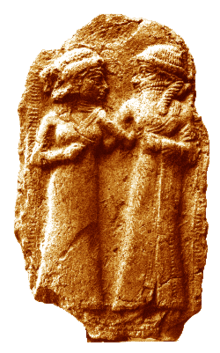
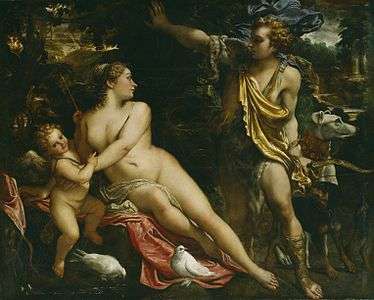
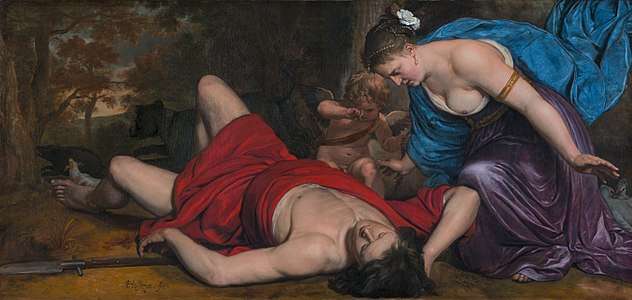


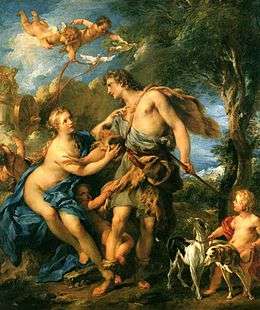
.jpg)